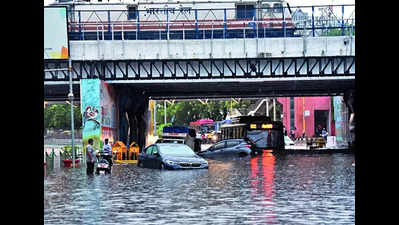- News
- City News
- delhi News
- Delhi rains: No light at the end of tunnel as usual suspects submerged again
Trending
Delhi rains: No light at the end of tunnel as usual suspects submerged again
Amidst infrastructure challenges, the recurring waterlogging issues at key locations like the Minto Road underpass and Pragati Maidan transit corridor call for urgent and effective solutions to prevent disruptions and ensure public safety.

A PWD official admitted, "Our systems couldn't handle so much rain in such a short spell. There was also the problem of a DJB drain overflowing near the site causing a lot of water to accumulate in the low-lying spot." DJB officials denied the claims made by PWD.
The Minto Road underpass, located at the junction between Deen Dayal Upadhyay Marg and Connaught Place, has been identified as a Top 10 waterlogging hotspots of the city. Following the death of a 56-year-old man in 2020 when his truck was submerged at the underpass, certain protocols were initiated to prevent govt from facing the annual embarrassment at the underpass. In 2021, two drains were built and connected to an underground sump beside the Minto road pump house. However, these measures proved ineffective, and traffic police had to close the infamous underpass on Friday to prevent major incidents.
The Pragati Maidan transit corridor, consisting of one main tunnel and six underpasses, has also become a significant problem for govt agencies. PWD, which currently manages the network, has pointed out problems existing inside the tunnel on several occasions. Officials cited two main reasons for the latest episode of waterlogging inside the tunnel: rainwater entering from the underground parking due to seepage in the walls and PWD using the tunnel as a 'drain' to dispose of the accumulated water on Mathura Road in front of the VIP area there.
During the construction of the Pragati Maidan tunnel, several measures had been taken to prevent waterlogging inside the tunnel. However, in the rainy season last year, the tunnel was flooded for several days, despite arrangements like roofs on the ramps of the tunnel entrance, stormwater drains and underground sumps to handle excess water. The tunnel, associated with Bharat Mandapam, the main venue of the G20 summit in September last year, is considered a project of national importance. And yet, the measures taken to prevent it being inundated haven't proved sufficient to prevent waterlogging and being closed to traffic for several days this year.
Given the lapses plaguing the tunnel system, PWD had sent a Rs 500-crore legal notice on infra giant L&T, holding it responsible for the poor construction work on the transit corridor. It said in its notice that "serious technical deficiencies" had led to consequent damages and inadequacies. Two months ago, an expert committee submitted a 20-point report to lieutenant governor VK Saxena highlighting the problems in the tunnel and the possible solutions involving the assistance of other govt departments.
It wasn't just the Pragati Maidan tunnel, but also roads around Bharat Mandapam that faced submergence on Friday. PWD officials said Bhairon Marg, Purana Qila Road, Bhagwan Das Road and Mathura Road were waterlogged after the heavy showers early in the morning.
The W-point at ITO Skywalk also remained flooded for several hours. According to officials, the regulator drain No. 12 A, which caters to Mathura Road, Supreme Court and the surrounding area, was clogged with accumulated silt. This caused problems in removing the rainwater from the locations even after deploying motor pumps.
End of Article
FOLLOW US ON SOCIAL MEDIA










